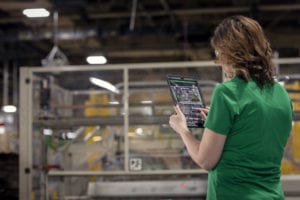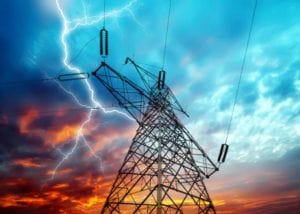In this post, we will look at where power analytic capabilities are used – from the device to the edge to the cloud – and examples of applications. This is the third post in my series on the benefits of power analytics in the ‘New Electric World’ to make complex electrical distribution systems more resilient and efficient. In my last post we looked at the importance of data quality for accurate insights.
Management guru Peter Drucker said: “If you can’t measure it, you can’t improve it.” I will take the liberty of refining that point by saying: If you can’t analyze it, you can’t improve it. Though measurement produces important data, data must be turned into actionable information. This is where analytics comes in.
Analytics is the key to understanding, making decisions, and acting on them. It is not just for top-level executives who need the ‘big picture’ regarding investment risks and opportunities. Analytics can and should be used at every level in an organization. When it comes to your electrical infrastructure, power analytics can help deliver insights to everyone from maintenance personnel to facility engineers and energy managers.
Power analytics can be applied to every situation – spanning timeframes from milliseconds to months – that affects your facility’s power resilience and efficiency. To unlock this value, however, analytic intelligence must run at every layer in your enterprise, from connected devices throughout your electrical network, to ‘edge’ applications in your facility, to cloud applications.

Power Analytic Algorithms: Creation vs. Operation
Before we talk about how analytics operate at every level, let’s discuss how and where you create algorithms. Typically, you use a cloud platform to gather data, build an analytic algorithm, and then deploy it. For example, the Tesla Autopilot™ algorithms running in Tesla cars are designed, built, and industrialized in the cloud before they are deployed to vehicles.
A common way to build analytics algorithms is with machine learning. Here, real-world data is used to ‘train’ the algorithm in the cloud. This data comes directly from the devices and the environment where the algorithm will be deployed. Machine learning trains the algorithm to recognize conditions such as deviations from normal operation, or to recognize categories or stages of operation. Once an analytic algorithm is built this way in the cloud, it can be deployed anywhere. This example shows how power analytics creation and operation can work across tiers.
You want to improve a transformer relay algorithm to avoid tripping the circuit breaker during a current inrush condition when a transformer energizes. You will use a cloud platform to gather time-series voltage and current training data from multiple transformers as they are energized. Using this ‘big data’, you will train an algorithm to recognize the inrush condition, then test it to confirm that it can recognize the inrush faster than a traditional method. If the testing confirms that the machine learning approach was faster and more accurate, you then deploy the new algorithm into a transformer relay. The relay will now detect the inrush condition faster to prevent a breaker trip.
Now, let us look at how multiple tiers of analytic tools can deliver value throughout your organization.
3 Tiers of Power Analytic Benefits
We have seen how to create an analytic algorithm and then to deploy it for operation. But what criteria determines which tier is best to deploy an analytic application? This table summarizes the criteria and offers examples.
| Tier | Decision Timeframe | Decision Context | Suitable Power Analytics Applications |
|---|---|---|---|
| Cloud | Minutes |
Global
|
|
| Edge | Seconds |
Site/System
|
|
| Connected Device | Milliseconds |
Equipment/Room level
|
|
Match Analytics Capabilities to the Application
Let us dive deeper into an example of using analytics at the edge to show the importance of matching the capabilities of the tier with the needs of the application. With intelligent event management, situational awareness for operators and engineers is critical. When a system-wide electrical incident occurs, these users are typically presented with an overwhelming amount of data in the form of alarm floods, texts, and phone calls. The time is takes to process all this information can extend the time to recovery rather than shorten it.
Event management analytics can make sense of all the event data in a timely fashion but only if deployed at the edge level. The analytics require too much site and system context to be deployed at a device level, where a device does not ‘see’ beyond the equipment it is monitoring. The analytics also require fast response times that cannot be reliably provided from the cloud tier. Therefore, the edge tier is the right place to deploy analytics for managing electrical events at a system level.
Modern edge platforms used for monitoring and control contain analytics that help operators recover faster after an electrical incident. A good example you will see in these platforms is related to alarm grouping. If you have hundreds of devices generating alarms and events, it can be overwhelming to diagnose the root cause. However, by using analytics to group alarms that are related either in time (i.e. happening at the same time) or in space (i.e. happening on the same electrical circuit) or by type (i.e. power quality events), we can present a more intuitive view of the system, saving operators precious time to recover.
Virtualization Extends the Value of Power Analytics
We saw how different types of analytics are suited to different tiers. Now, let’s look at cases where analytic algorithms run in multiple tiers, or move from one tier to another. Using ‘virtualization,’ you can configure an algorithm on one platform to run on another.
- From device to edge. In our first example, we had an inrush detection analytic algorithm running in a relay Thanks to virtualization, we can take that same algorithm and deploy it into an edge server to monitor several transformers from a single edge platform. This reduces capital costs because one device (the server) is used for all transformers instead of using one relay device per transformer. This also reduces operating expenses due to upgrades, maintenance, and expansion.
- From cloud to device. Consider a cloud-based condition monitoring algorithm for motors that uses a digital twin of the motor to monitor actual versus expected performance. In situations where cloud access is too expensive, or where customers have existing onsite maintenance teams, this same algorithm can be deployed to devices. For example, advanced meters can run the algorithm that monitors each motor onsite, then alerts onsite personnel when proactive maintenance is required.
In these examples, you can see that virtualization enables a wider set of applications that can extend the value of power analytics.
Learn About Power Analytics, EcoStruxure, and Much More
The IoT-enabled, future-proof EcoStruxure™ Power architecture from Schneider Electric supports digitized power distribution. This enables enhanced connectivity, real-time operations, and smart power analytics. EcoStruxure Power Advisor is a proactive, analytics-based service for your power management system. It delivers optimized energy performance, power reliability, and resilience.



